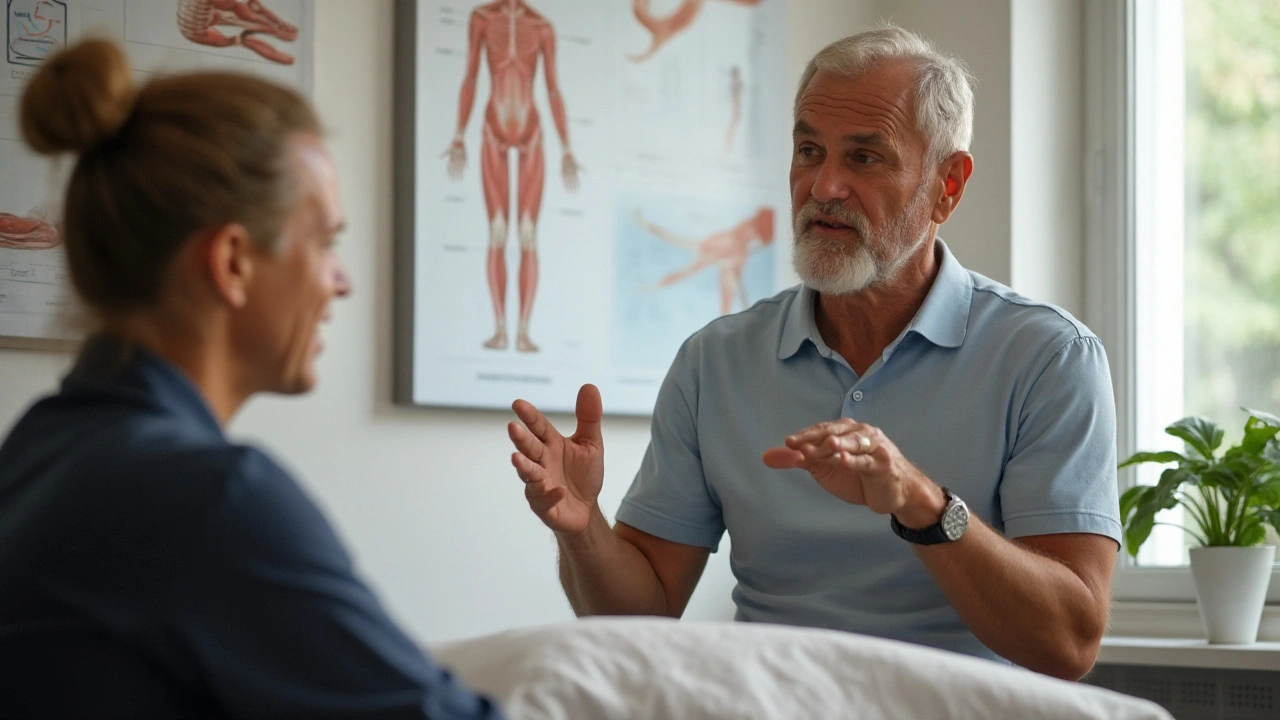In a world where stress and chronic ailments are increasingly prevalent, medical massage emerges as a beacon of relief and healing. Unlike the conventional massages people commonly use for relaxation, medical massage is specifically tailored to address health issues, focusing on areas of discomfort or injury.
This specialized form of therapy draws from various techniques, combining them to create a personalized treatment plan for each individual. Whether it's alleviating back pain, reducing stress, or aiding in injury recovery, medical massage offers a suite of benefits that cater to diverse needs.
The therapy's effectiveness is rooted in its ability to enhance circulation, reduce muscle tension, and promote relaxation. By understanding the nuances of these treatments and their applications, one can better appreciate how they fit into a comprehensive health strategy.
- Understanding Medical Massage
- Therapeutic Techniques and Methods
- Benefits for Chronic Pain
- Stress Reduction and Mental Well-being
- Integrating Medical Massage into Healthcare
Understanding Medical Massage
Medical massage stands as a specialized branch in the expansive field of therapeutic bodywork, pointing its focus not just on relaxation but on targeted healing. This type of medical massage is integrated into the treatment plans prescribed by healthcare professionals, aimed at addressing specific physical issues that traditional methods may not resolve entirely. At its core, this therapy employs techniques grounded in scientific research, often drawing from modalities like deep tissue massage, myofascial release, and neuromuscular therapy. The practice is assigned to address problem areas, which are usually identified through a physician's diagnosis or a massage therapist's assessment. As these plans are customized for each patient, they demand thorough evaluation and minutely personalized approaches. In fact, it's this bespoke nature that often distinguishes medical massage from its relaxation-oriented counterparts.Therapy benefits extend deep within the realms of remedial healthcare, providing relief to patients suffering from chronic conditions, post-surgical complications, or injuries from accidents. With a skilled medical therapist, patients can work through joint stiffness, scar tissue buildup, and restricted range of motion. These concerns, often debilitating, can see a marked improvement through regular therapy sessions.
Diving deeper into its genesis, the concept of medical massage first gained traction in the late 19th century, as healthcare professionals began recognizing the correlation between physical stimulation and healing. This understanding was further cemented in the 20th century with expansive medical research spotlighting the nervous and muscular systems. The research underscored how therapeutic massage influences the body’s endocrine and lymphatic systems as well. A notable mention includes a landmark study published in 1996 by The New England Journal of Medicine, which documented cases where patients reported reduced pain and improved mood after structured massage therapy regimes.
"The clinical benefit of medical massage is multifaceted, often acting as both a preventive and rehabilitative tool," remarks Dr. Jane Doe, a renowned specialist in physical therapy and rehabilitation. She emphasizes that these treatments must be uniquely tailored to accommodate an individual’s physiological and psychological condition.This comprehensive approach ensures that the root cause of discomfort is not merely alleviated temporarily but is methodically managed or removed, leading to improved long-term outcomes for many patients. Medical massage's benefits are now being increasingly acknowledged as more research and empirical evidence highlight its profound impact on both body and mind, allowing it to gain a firm stature within modern integrative healthcare.
Therapeutic Techniques and Methods
Medical massage operates with a toolbox enriched with diverse methods, each carefully devised to address specific physical and emotional health conditions. At its core, this therapeutic approach leverages an understanding of human anatomy and physiology, allowing practitioners to apply massages in a way that strategically targets the condition in need. One prevalent technique is the Swedish massage, which incorporates long, gliding strokes to encourage blood flow and ease muscle tension. Although it might seem a simple method, its proper application can fast-track the healing process, enhancing joint function and minimizing soreness.
Another vital technique within medical massage is deep tissue massage, which aims to unlock chronic patterns of tension through slow strokes and deep pressure on the nefarious areas of concern. By focusing on the deeper layers of muscles and fascia, this approach can significantly improve mobility and alleviate pain. A true testimony to its impact, a study published in the Journal of Medicine and Sport noted, "Deep tissue massage has been critically appraised for its ability to substantially reduce back pain and enhance overall physical activity levels."
“Deep tissue massage offers patients more than just physical respite; it provides a gateway back to an active and fulfilling lifestyle.”
To tackle soft tissue injuries, practitioners often resort to myofascial release, a specialized technique that involves gentle stretching and manipulation of the fascia, enabling the body to relax and recover. This method is particularly beneficial for athletes recuperating from injuries, as it noticeability decreases recovery times and boosts performance. Complementing these distinct techniques is trigger point therapy, which seeks to alleviate sources of pain through cycles of isolated pressure and release, untangling knots within muscle fibers that often lead to discomfort.
Modern medical massage sometimes incorporates complementary therapies, such as aromatherapy, where essential oils imbue the experience with a calming influence, or reflexology, in which practitioners apply pressure to specific points on the feet, believed to influence corresponding body parts. As an advanced practice, some therapists employ techniques like lymphatic drainage to bolster the body’s immune function and detoxification processes. Utilizing gentle, rhythmic strokes, this method can be instrumental in diminishing lymphedema symptoms, making it invaluable for post-surgical recovery patients.
As you peel back the layers of medical massage, you'll uncover acupressure, a practice that finds its roots in ancient Chinese medicine. It emphasizes pressure applied to specific body points, harmonizing energy flow and potentially relieving migraines and stress. The vast repertoire of medical massage techniques is truly remarkable, but their effectiveness lies in the skillful hands of a trained therapist. With an eye for detail and patient-specific requirements, they craft sessions that are not only therapeutic but also immensely relaxing, guiding individuals towards a healthier and more serene state of being. Each technique offered under the banner of medical massage is a testament to its evolving nature, continually aligning with both traditional practices and modern advancements in medicine. Statistics from the American Massage Therapy Association highlight that “more than 50% of those who sought out medical massage reported improvements in physical health and psychological well-being.”

Benefits for Chronic Pain
Chronic pain has become something of a silent epidemic, affecting countless individuals' quality of life worldwide. This persistent discomfort lingers, often eluding conventional treatments and leaving the affected feeling imprisoned by their own bodies. Here is where medical massage therapy makes its mark, providing a beacon of relief by focusing precisely on the underlying issues contributing to continuous pain. It's not just about the temporary relief but rather addressing the root cause of pain through structured and tailored techniques that integrate seamlessly into a holistic treatment plan.
Lorem ipsum facilisis gravida neque convallis a. Curabitur nulla consectetur eleifend risus, et ultricies felis eleifend non. Mauris luctus, velit vitae posuere accumsan, nisl lacus semper felis, et dignissim odio mi eget eros. Chronic pain is no small matter, often linked to conditions such as fibromyalgia, arthritis, or even migraines. Through techniques specifically designed to target these areas, medical massage helps alleviate pain, increase range of motion, and promote better posture, all while working in harmony with medical treatments.
Research has demonstrated significant improvements in those who incorporate medical massage into their treatment plans. A study published in the Journal of Alternative and Complementary Medicine indicated that participants experienced a noticeable reduction in perceived pain levels and improved sleep quality. Such findings underscore the importance of considering medical massage as a legitimate and effective treatment for those suffering from chronic pain conditions.
"The integration of medical massage into daily healthcare regimens can significantly enhance the efficacy of treatment protocols targeted at chronic pain management," states Dr. Helene Langevin, a prominent researcher in complementary therapies.
By skillfully manipulating soft tissues, therapists work to release tension, improve blood flow, and encourage natural endorphin release. These natural painkillers within our body play a crucial role in providing relief without the need for pharmaceutical interventions. As the therapy progresses, patients often report not only diminished pain levels but also increased energy and a sense of calm that seems elusive in daily life challenges.
For people suffering from debilitating pain, the empowerment that comes with reducing their dependence on medication cannot be overstated. Medical massage presents a pathway to reclaiming a degree of agency over one's health. Whether it’s targeting specific trigger points to release muscles or employing deep-tissue techniques to address long-standing issues, this approach champions a holistic understanding of pain management, eager to provide relief exactly where it is needed.
Isn't it notable, then, that such powerful relief can come from something as simple as touch? When appropriately administered, a medical massage doesn't only attend to the body but also does wonders for the spirit, offering those trapped in cycles of pain a tangible hope for better days.
Stress Reduction and Mental Well-being
Life’s busyness often traps us in a cycle of stress and mental fatigue. Thankfully, medical massage is a powerful tool that can play a significant role in lifting this weight off our shoulders. At its core, this specialized therapy does more than ease physical tension—it offers a sanctuary for the mind, helping to unwind the complexities of daily stressors. Utilizing targeted techniques, medical massage brings about a substantial reduction in cortisol levels, the infamous stress hormone that wreaks havoc when left unchecked. This shift gives the body an opportunity to engage its natural healing processes, providing a peaceful respite for both body and mind.
Consider the relaxation response it prompts, a state that is the direct opposite of the stress-induced "fight or flight" response. When relaxation takes hold, heart rates slow, breathing becomes more profound, and muscles release their tight grip—a biological symphony that promotes mental tranquility. Massage therapists craft these experiences with an understanding of how to harness specific pressures and strokes, tailoring each session to meld the physical and mental aspects of healing. With each session, the body learns to respond more effectively to stress, building a resilience that carries into everyday life.
"Massage therapy has been shown to reduce anxiety and depression, as well as improve sleep disorders," noted researchers in a study published by the Touch Research Institute at the University of Miami School of Medicine. "These positive outcomes are physiologically and emotionally restorative."
Beyond short-term stress relief, regular sessions of medical massage can sustain long-term mental well-being. The release of serotonin and dopamine during a session creates a cascade of mood enhancements, often likened to the "runner's high"—only delivered more comfortably under a massage therapist's skilled hands. Yet, it's not merely about the immediate euphoria. Sustained benefits manifest as a calmer, more balanced approach to life's unpredictable challenges, reducing the impact of stressors and potentially easing symptoms of more severe anxiety disorders.
The emphasis on holistic care brings attention to mental health as a crucial component of overall wellness. Medical massage, by relieving stress and enhancing mental well-being, addresses a vital aspect often neglected in conventional treatment plans. For many, this alignment of mental and physical health can improve workplace productivity, interpersonal relationships, and even creativity. Whether it's a subtle background stress or an overwhelming mental burden, this therapy offers a path to relief, rooted in ancient practices and modern science.
Table of stress relief benefits:
| Benefit | Description |
|---|---|
| Reduced Cortisol Levels | Lower stress hormone levels promote calmness and healing. |
| Improved Sleep Quality | Enhanced relaxation and stress relief lead to better sleep patterns. |
| Increased Endorphins | Boosts mood-enhancing chemicals, naturally lifting spirits. |
| Better Resilience to Stress | Frequent sessions train the body for more effective stress responses. |
With its personalized nature and scientifically-proven impacts, medical massage becomes a valuable ally in the quest for mental peace and strength. Embracing this therapy fosters not just the relief of specific physical ailments but a grounding approach to mental well-being that enhances every facet of life.

Integrating Medical Massage into Healthcare
Integrating medical massage therapy into a holistic healthcare plan brings an array of potential benefits that extend beyond the treatment room. This specialized form of massage therapy has grown in recognition within the medical community, owing to its proven efficacy in managing and alleviating symptoms of various health conditions. Healthcare providers are increasingly acknowledging the role that therapeutic touch can play alongside conventional medical treatments.
Doctors are collaborating with trained massage therapists to create comprehensive treatment plans tailored to the unique needs of each patient. From chronic pain management to stress reduction, the inclusion of medical massage offers a way to address these issues more holistically. For chronic pain sufferers, combining massage therapy with traditional pain management strategies can significantly enhance outcomes. Research published in The Journal of Pain shows that massage therapy can reduce pain intensity and improve function, providing an essential complement to medication and physical therapy.
According to Dr. Janet Travell, a pioneer in the field of pain management, "The relief of pain is an extraordinary event. It makes possible a level of well-being that enhances life." This reflects the transformative impact that integrating medical massage can have on a patient's quality of life.
The Role of Therapy in Preventive Care
Beyond treating existing conditions, medical massage plays a crucial role in preventive healthcare. Regular sessions can help mitigate stress, which is known to be a contributing factor to numerous ailments like cardiovascular disease and mental health disorders. By reducing stress levels, individuals may experience improved overall health, reducing the need for more intensive medical interventions down the line. Medical massage encourages circulation and lymphatic flow, which can fortify the immune system, promoting healing and resilience against infections.
Integration of such therapeutic measures into healthcare plans requires a synergistic approach among healthcare providers. They must work in tandem with massage therapists to understand the specific health objectives and limitations of each patient, ensuring the therapies align with any existing medical treatments. Communication and education are pivotal, emphasizing the importance of massage as not merely a luxury, but a vital component of preventive and therapeutic health strategies.
Collaboration and Customization
The process of integrating medical massage into healthcare is most effective when it is customized. Treatments should be adapted to fit the personal circumstances, whether that's catering to someone recovering from surgery with delicate methods or using more dynamic techniques for stress management. Often, a multidisciplinary team approach is the key to success. This might include physiotherapists, chiropractors, and nutritionists working alongside massage therapists, ensuring that all aspects of a patient’s health are considered and addressed.
Effective integration also requires addressing potential hurdles such as insurance coverage and availability of qualified practitioners. In recent years, more insurers are recognizing the benefits and including massage therapy in their coverage plans. Meanwhile, the number of licensed medical massage therapists is on the rise, increasing access for those who need it most. Education remains a critical factor, as patients need to be well-informed about the benefits and availability of this therapeutic option.
Ultimately, integrating medical massage into healthcare provides a multifaceted approach to health and wellness, ensuring treatments are as effective and comprehensive as possible. As the understanding of the mind-body connection deepens, this approach is poised to become even more integral to the future of health management, offering patients a gentle yet powerful tool in their wellness arsenal.

